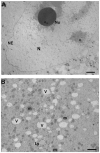Ultrastructural Evaluation of the Human Oocyte at the Germinal Vesicle Stage during the Application of Assisted Reproductive Technologies
- PMID: 35626673
- PMCID: PMC9139706
- DOI: 10.3390/cells11101636
Ultrastructural Evaluation of the Human Oocyte at the Germinal Vesicle Stage during the Application of Assisted Reproductive Technologies
Abstract
After its discovery in 1825 by the physiologist J.E. Purkinje, the human germinal vesicle (GV) attracted the interest of scientists. Discarded after laparotomy or laparoscopic ovum pick up from the pool of retrieved mature oocytes, the leftover GV was mainly used for research purposes. After the discovery of Assisted Reproductive Technologies (ARTs) such as in vitro maturation (IVM), in vitro fertilization and embryo transfer (IVF-ET) and intracytoplasmic sperm injection (ICSI), its developing potential was explored, and recognized as an important source of germ cells, especially in the case of scarce availability of mature oocytes for pathological/clinical conditions or in the case of previous recurrent implantation failure. We here review the ultrastructural data available on GV-stage human oocytes and their application to ARTs.
Keywords: assisted reproductive technologies (ARTs); electron microscopy; germinal vesicle; human; oocyte.
Conflict of interest statement
The authors declare no conflict of interest.
Figures


References
-
- Aristotle. Generation of Animals, with an English Translation by A.L. Peck. William Heinemann LTD; London, UK: Harvard University Press; Cambridge, MA, USA: 1943.
-
- Harvey W. Exercises of Animal Generation. In: Pulleyn I.O., editor. Exercitationes de Generatione Animalium. Typis Du-Gardianis; London, UK: 1651.
-
- Turriziani Colonna F. De Ovi Mammalium et Hominis Genesi (1827), by Karl Ernst Von Baer. Center for Biology and Society, School of Life Sciences, Arizona State University; Tempe, AZ, USA: 2017. [(accessed on 25 March 2022)]. (Embryo Project Encyclopedia). Available online: http://embryo.asu.edu/handle/10776/11405.
-
- De Graaf R. De Mulierum Organis Generationi Inservientibus. Ex Officina Hackiana; Leiden, The Netherlands: 1672. The Female Organs in the Service of Generation.
Publication types
MeSH terms
LinkOut - more resources
Full Text Sources

